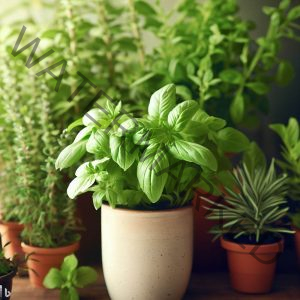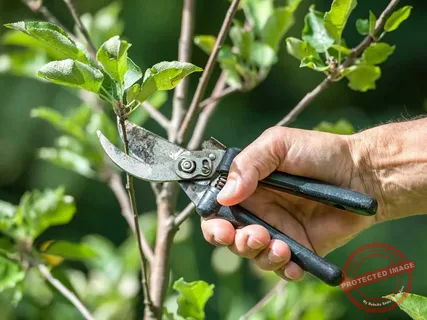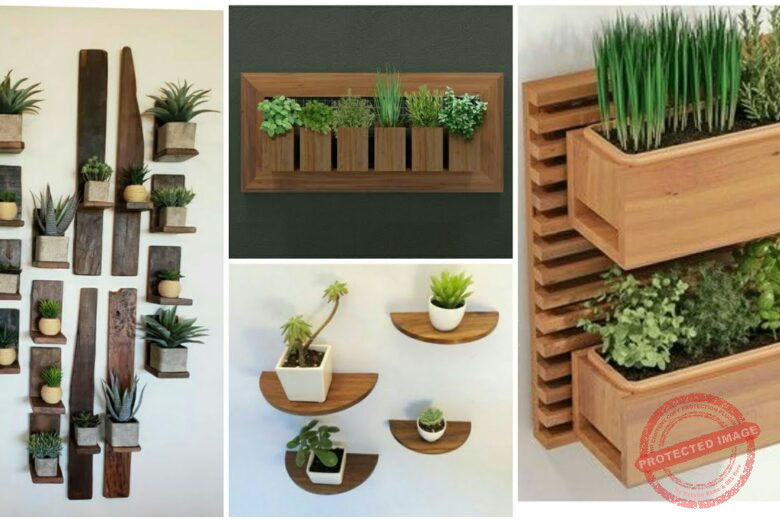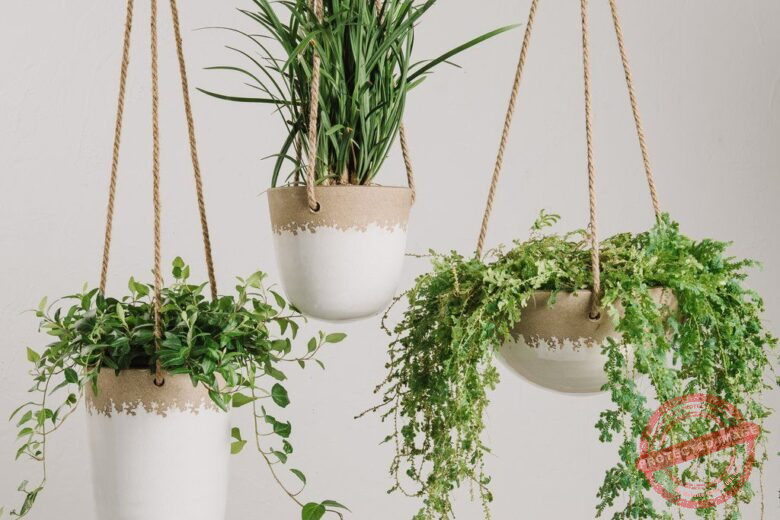Are you an aspiring gardener with limited outdoor space? Or perhaps you’re just looking to add a touch of greenery to your home? Growing herbs indoors can be a delightful and rewarding experience. Not only do indoor herbs provide fresh flavors for your culinary creations, but they also enhance your living space with their vibrant colors and fragrances.
The easiest indoor herbs to grow include versatile basil, refreshing mint, mild chives, versatile parsley, aromatic rosemary, earthy thyme, robust oregano, distinctive cilantro, flavorful sage, soothing lemon balm, aromatic dill, fragrant lavender, depth-enhancing bay laurel, natural sweetener stevia, zesty lemongrass, anise-like tarragon, milder marjoram, unique fennel, earthy cumin, and minty wintergreen.
20 Easiest Herbs To Grow Indoors Step By Step Guide

1. Basil
Basil is a beloved herb known for its distinctive aroma and versatile use in various cuisines. Its fragrant leaves can range from sweet to spicy, depending on the variety. Basil prefers warmth and plenty of sunlight, making it an excellent candidate for indoor growing. Keep the soil consistently moist and pinch off the flower buds to encourage leaf growth.
Read Also: 25 Best Indoor Vegetable Garden System
2. Mint
Mint is a rapid grower that offers a refreshing and invigorating flavor. With a multitude of varieties like peppermint, spearmint, and chocolate mint, you can explore different taste profiles. Mint appreciates bright light but benefits from some protection against intense sunlight. Regularly trim its stems to prevent leggy growth, and consider growing it in a separate container to avoid its vigorous spreading tendencies.
3. Chives
Chives are members of the onion family and are prized for their mild, onion-like flavor. These slender green shoots add a delicate touch to dishes and are often used as garnishes. Chives require moderate sunlight and well-drained soil. As they grow, you can snip the leaves from the base, ensuring new growth continues to emerge.
Read Also: [Beginners Guide] How Long Does It Takes Arugula To Grow?
4. Parsley
Parsley is a versatile herb that’s both flavorful and nutritious. With curly and flat-leaf varieties, you can choose based on your preferences. Parsley appreciates indirect sunlight and consistent moisture. Harvest its leaves from the outer parts of the plant, allowing the center to continue growing.
5. Rosemary
Rosemary is a woody herb with an invigorating aroma. It’s perfect for infusing meats, potatoes, and even bread with its distinct flavor. Rosemary prefers full sunlight and well-drained soil. Be cautious with watering; let the soil dry out between waterings to prevent root rot.
Read Also: Top 50 Fast Growing Fruits In Pots
6. Thyme
Thyme is a small, bushy herb that adds earthiness to dishes. Its tiny leaves pack a big flavor punch. Thyme thrives in bright light and well-drained soil. Allow the soil to dry out between waterings, but don’t let it become bone dry. Prune the stems regularly to maintain its shape and encourage new growth.
7. Oregano
Oregano is a must-have herb in Mediterranean and Italian cuisine. It offers a robust, savory flavor that pairs well with various dishes. Oregano requires plenty of sunlight and well-drained soil. Regular pruning will keep it from getting leggy and encourage bushier growth.
Read Also: [Beginners Guide] How To Grow Butternut Squash Vertically
8. Cilantro
Cilantro is known for its distinctive flavor that people either love or find polarizing. It’s a staple in Mexican, Indian, and Southeast Asian dishes. Cilantro prefers bright light and consistent moisture. It tends to bolt quickly, so sow seeds every few weeks to ensure a continuous harvest.
9. Sage
Sage has a strong, earthy flavor that stands out in both culinary and medicinal applications. It prefers bright light and well-drained soil. Sage can become quite large, so make sure to provide it with sufficient space to spread out.
Read Also: Avocado Seed Growing Stages [A Comprehensive Guide]
10. Lemon Balm
Lemon balm is prized for its lemony fragrance and soothing properties. It’s often used to make herbal teas and infusions. Lemon balm thrives in partial shade and regular watering. Trim its flowers to prevent them from taking energy away from leaf production.
11. Dill
Dill has feathery leaves and a distinctive flavor that’s perfect for pickling and seafood dishes. Dill enjoys full sunlight and well-drained soil. Since dill tends to have a shorter lifespan, consider succession planting to maintain a steady supply.
12. Lavender
Lavender is both a fragrant herb and a charming ornamental plant. Its soothing aroma is often used for relaxation and aromatherapy. Lavender requires plenty of sunlight and well-drained soil. To encourage bushier growth, prune the plant after flowering.
13. Bay Laurel
Bay laurel leaves are used to add depth to soups, stews, and other slow-cooked dishes. This slow-growing herb thrives in bright light and well-drained soil. Since it can grow quite tall, ensure you have enough vertical space for it.
Read Also: [Beginner’s Guide] Planning Your Vegetable Garden Layout
14. Stevia
Stevia is a natural sweetener that’s significantly sweeter than sugar. Its leaves can be used to sweeten beverages and desserts. Stevia prefers moderate sunlight and consistent moisture. Keep in mind that it might have a slightly bitter aftertaste for some people.
15. Lemongrass
Lemongrass imparts a zesty, lemony flavor to dishes and teas. It thrives in bright light and regular watering. Lemongrass can grow quite tall, so choose a container that accommodates its height.
16. Tarragon
Tarragon has an anise-like flavor that’s a staple in French cuisine. It enjoys bright light and moderate watering. Regularly pruning its stems will prevent it from becoming overly woody.
Read Also: 50 Fastest Growing Vegetables and Fruits [2-9 Weeks]
17. Marjoram
Marjoram offers a milder flavor compared to its cousin oregano. It requires well-drained soil and moderate sunlight. As it grows, you can harvest the leaves for use in cooking.
18. Fennel
Fennel has a unique licorice-like flavor that’s used in both culinary and medicinal contexts. It appreciates full sunlight and well-drained soil. Fennel can grow quite large, so choose a container with sufficient space.
19. Cumin
Cumin is known for its earthy and warm flavor that enhances many dishes. It thrives in bright light and well-drained soil. Allow the soil to dry out between waterings to prevent overwatering.
20. Wintergreen
Wintergreen leaves have a minty flavor and are often used in teas and flavorings. It prefers partial shade and consistently moist soil. Wintergreen can spread through underground runners, so consider planting it in a separate container.
Benefits of Growing Herbs Indoors
Before we dive into the list of the easiest herbs to grow indoors, let’s take a moment to appreciate the benefits of cultivating herbs within your living space. Indoor herb gardening offers several advantages:
Convenience: Having fresh herbs at your fingertips makes cooking a breeze. No more last-minute trips to the grocery store for a small bunch of basil!
Aesthetic Appeal: Indoor herbs bring a touch of nature indoors, adding beauty and vibrancy to your living spaces.
Health Benefits: Many herbs possess medicinal properties. For example, mint and chamomile can aid in digestion, while lavender promotes relaxation.
Educational Opportunity: Indoor gardening provides a hands-on learning experience for both adults and children, fostering an understanding of plant growth and care.
Choosing the Right Location
To ensure the success of your indoor herb garden, choose a location that receives ample sunlight. Most herbs thrive in at least 4 to 6 hours of direct sunlight daily. South or west-facing windows are usually the best options. If natural light is limited, consider using grow lights to supplement the lighting conditions.
Selecting the Perfect Containers
Herbs can be grown in various containers, such as pots, planters, or even repurposed containers like mason jars. Ensure that your chosen containers have drainage holes to prevent waterlogging, which can lead to root rot. Using containers with saucers underneath will catch excess water and protect your indoor surfaces.
Essential Indoor Herb Growing Tips
Providing Adequate Light
Light is essential for photosynthesis, the process by which plants convert light into energy. Herbs require sufficient light to grow and flourish. If natural light is insufficient, supplement it with artificial grow lights. LED grow lights are energy-efficient and provide the right spectrum for plant growth.
Maintaining Proper Humidity
Indoor environments can sometimes be dry, especially during winter months when heating systems are running. Many herbs prefer moderate humidity levels. To increase humidity, mist your herbs regularly or use a humidity tray filled with water and pebbles placed near your plants.
Optimal Temperature Conditions
Most herbs thrive in temperatures between 60°F and 70°F (15°C to 21°C). Avoid placing your herbs near cold drafts or heat sources such as radiators. Consistent temperature conditions will promote healthy growth.
Watering Techniques
Overwatering is a common mistake in indoor gardening. Herbs prefer slightly moist, well-draining soil. Water your herbs when the top inch of the soil feels dry to the touch. Always water at the base of the plant to avoid wetting the leaves, which can lead to fungal issues.
Planting and Caring for Indoor Herbs
You can grow herbs from seeds or purchase young transplants. Starting from seeds offers a sense of accomplishment, and transplants provide a head start.
Soil Mix and Fertilization
Use a well-draining potting mix with added perlite for proper drainage. Fertilize your herbs every few weeks with a diluted liquid fertilizer.
Pruning and Harvesting
Regular pruning encourages bushy growth and prevents legginess. Harvest herbs in the morning when their flavors are most concentrated.
Creative Ways to Use Your Indoor Herbs
Culinary Delights
Experiment with your indoor herbs by incorporating them into a variety of dishes. Infuse oils, make herb butter, or create unique herb blends for seasoning.
Aromatherapy and Home Decor
Herbs like lavender, rosemary, and mint can be used to create potpourri, sachets, or even essential oils for aromatherapy. Their fragrances enhance your home environment. Dry fragrant herbs like lavender, rosemary, and mint to create potpourri or sachets that infuse your living spaces with delightful scents. You can also experiment with making essential oils from these herbs to use in aromatherapy diffusers or as natural air fresheners.
How Long Do Herbs Take to Grow Indoors?
The growth rate of herbs varies depending on the type of herb and growing conditions. Generally, herbs like basil, mint, and parsley can start producing usable leaves within a few weeks to a couple of months after planting. Other herbs like rosemary, thyme, and oregano may take a bit longer to establish before they reach full harvesting potential.
How Do You Grow Herbs Indoors for Beginners?
If you’re new to indoor herb gardening, here’s a step-by-step guide to help you get started:
Choose the Right Herbs: Begin with easy-to-grow herbs like basil, mint, or chives. These herbs are forgiving and more likely to thrive in indoor conditions.
Select Suitable Containers: Opt for containers with drainage holes to prevent overwatering. Consider the size of the mature herb when choosing the pot size.
Use Quality Potting Mix: Use a well-draining potting mix specifically formulated for container gardening. Avoid using garden soil, as it can compact in containers and hinder drainage.
Provide Adequate Light: Place your herbs in a sunny spot where they can receive at least 4-6 hours of direct sunlight daily. If natural light is limited, supplement with grow lights.
Water Carefully: Water your herbs when the top inch of the soil feels dry to the touch. Avoid overwatering, as this can lead to root rot.
Maintain Humidity: Many herbs prefer moderate humidity levels. Mist your herbs or use a humidity tray to keep the air around them moist.
Prune Regularly: Pinch off the tips of your herbs to encourage bushy growth. Pruning also prevents legginess and helps maintain a compact shape.
Harvest Thoughtfully: Begin harvesting once your herbs have grown enough to sustain it. Harvesting encourages new growth, but avoid taking more than a third of the plant at once.
Fertilize Sparingly: Use a balanced liquid fertilizer diluted to half-strength every few weeks. Too much fertilizer can lead to weak growth and diminished flavor.
Monitor and Adjust: Keep an eye on your herbs and adjust care based on their growth. Each herb may have slightly different preferences.
Herbs That Can Grow Indoors With Low Light
While many herbs thrive in bright light, there are a few that can tolerate lower light conditions. If your indoor space has limited natural light, consider growing these herbs:
Mint: Mint can tolerate moderate to low light but will grow best with some exposure to sunlight.
Chives: Chives can handle lower light levels, making them a great choice for windowsills with less direct sunlight.
Parsley: Parsley can grow in partially shaded areas, but it will benefit from some indirect sunlight.
Remember that while these herbs can tolerate lower light, they may still perform better if you can provide them with at least a few hours of sunlight or artificial grow lights.
Best Herbs to Grow Indoors Year Round
Certain herbs are well-suited for year-round indoor growth due to their adaptability and continuous production. These herbs can thrive indoors regardless of the season:
Basil: With proper care, basil can grow indoors year-round. Regular pruning encourages continuous leaf production.
Chives: Chives are hardy and can provide a steady supply of flavorful leaves throughout the year.
Mint: Mint is known for its vigorous growth and can be harvested regularly for teas and recipes.
Thyme: Thyme is a compact herb that adapts well to indoor conditions, offering its earthy flavor all year.
Best Indoor Herb Garden
Creating the best indoor herb garden involves considering factors like space, light availability, and your personal preferences. Here’s a simple guide to creating your ideal indoor herb garden:
Assess Your Space: Determine the available space for your herb garden. This could be a windowsill, a countertop, or a dedicated corner with sufficient light.
Choose Your Herbs: Select herbs that suit your culinary preferences and growing conditions. Consider easy-to-grow herbs like basil, mint, and chives for beginners.
Select Containers: Choose containers that match your space and style. Make sure they have drainage holes to prevent overwatering.
Provide Adequate Light: Place your herb garden in a location that receives enough sunlight or supplement with grow lights if necessary.
Plant and Care: Plant your herbs in well-draining potting mix and provide appropriate care, including watering, pruning, and fertilizing.
Harvest and Enjoy: Regularly harvest herbs for your culinary endeavors and creative projects.
Remember that the best indoor herb garden is one that aligns with your preferences, fits your available space, and brings joy to your gardening experience.
How to Grow Herbs Indoors from Seeds
Growing herbs from seeds indoors can be a rewarding experience. Here’s a step-by-step guide to help you successfully grow herbs from seeds:
Gather Supplies: You’ll need seeds, seed trays or small pots, a well-draining potting mix, a spray bottle, and clear plastic wrap.
Fill Containers: Fill the seed trays or pots with the potting mix, leaving a small gap at the top.
Plant Seeds: Sprinkle the herb seeds evenly over the surface of the soil. For tiny seeds, lightly press them into the soil with your finger.
Cover with Plastic Wrap: Place clear plastic wrap over the trays or pots to create a mini greenhouse effect. This helps retain moisture and warmth.
Provide Light and Water: Place the containers in a bright location with indirect sunlight. Keep the soil consistently moist but not soggy.
Remove Plastic Wrap: Once the seeds germinate and seedlings emerge, remove the plastic wrap to allow air circulation.
Thin Seedlings: If multiple seedlings sprout in the same space, thin them by gently removing the weakest ones, leaving the strongest seedling.
Transplant if Necessary: When seedlings have developed a few sets of true leaves, you can transplant them into larger pots.
Continue Care: Water and care for your seedlings as they grow, providing sufficient light and maintaining appropriate moisture levels.
Harden Off and Transplant: Before moving your herb seedlings outdoors, gradually acclimate them to outdoor conditions to prevent shock.
Best Smelling Herbs to Grow Indoors
Growing herbs indoors not only provides fresh flavors for your recipes but also fills your home with delightful scents. Here are some of the best smelling herbs to consider growing indoors:
Lavender: Lavender’s soothing aroma is perfect for creating a calming atmosphere indoors.
Rosemary: The fragrant pine-like scent of rosemary adds an earthy and invigorating aroma to your home.
Lemon Balm: With its lemony fragrance, lemon balm is known for its stress-relieving properties.
Mint: The refreshing scent of mint not only enlivens your senses but also has energizing qualities.
Thyme: Thyme’s earthy aroma adds depth to your indoor environment.
Planting these aromatic herbs indoors not only provides sensory delight but also contributes to a soothing and inviting atmosphere.
Can I grow multiple herbs together in the same pot?
Absolutely! Mixing compatible herbs in the same pot can save space and create a visually appealing arrangement. Just ensure they have similar water and light requirements.
Do herbs need direct sunlight to thrive indoors?
While direct sunlight is ideal, many herbs can thrive in bright indirect light. Consider using grow lights if natural light is limited
How often should I water my indoor herbs?
Watering frequency depends on factors like humidity, container size, and herb type. Water when the top inch of soil feels dry to the touch.
Can I use regular garden soil for indoor herb cultivation?
It’s best to use a well-draining potting mix specifically designed for container gardening. Regular garden soil may compact and hinder drainage.
Are there any herbs that are particularly challenging to grow indoors?
Some herbs, like cilantro, can be trickier due to their tendency to bolt in warm conditions. Research specific care tips for each herb to ensure success.
Conclusion
Starting an indoor herb gardening journey allows you to connect with nature and enjoy the rewards of your efforts. Whether you’re an experienced gardener or a newbie, growing herbs indoors is a delightful adventure that brings both flavor and beauty to your home. With the right care and attention, you can cultivate a thriving herb garden that enriches your culinary experiences and enhances your living space.




It’s a shame printing is blocked, the basic one and at printfriendly-com also. One day the site will disappear as it happened with thousands of sites, and I won’t be able to read the note again.
We’re sorry you could not print this, we are definitely running away from copy and paste bloggers who may diminish the effectiveness of this content, we are assuring you of our full time support to always be here to support you and to continue being in business